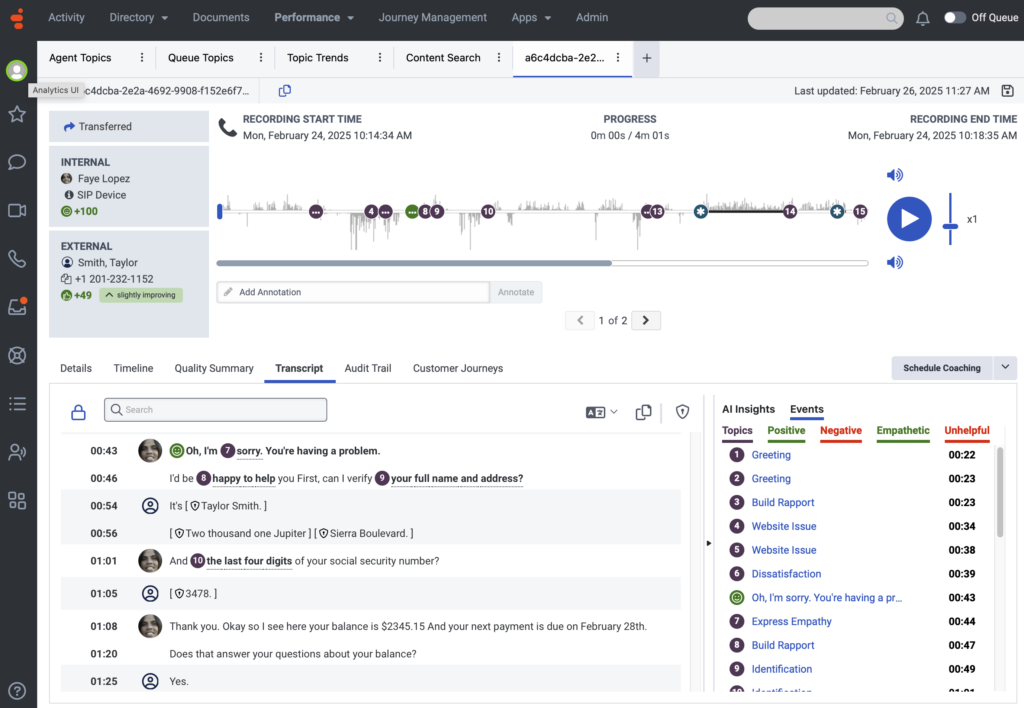Understand voice transcripts
A voice transcript is a textual representation of the words spoken during a voice interaction and provides a view into the interaction between the customer and internal participants (that is, IVR, ACD, agent, conference, or voicemail). When an interaction involves audio input (not all interactions include audio) and voice transcription is enabled, the audio streams to a transcription service, which then transcribes the audio into text format. The visual representation of the transcription includes timing and speaker specific information.
Use the Transcript tab to get better insight into the content of voice interactions, to improve training and feedback for call center employees, and to identify business problems.
- If a mid-call failure occurs, the system will not produce a voice transcription for that interaction.
- Although specific configuration is not required for the transcription of interactions that do not contain audio, the ability to generate voice transcripts that are shown in the Transcript tab is dependent on licensing, deployment type and language. For more information, see Configure voice transcription.
- Transcripts are encrypted and are safely stored to protect them from unauthorized access. Transcriptions and recorded interactions use the same type of encryption. For more information, see Encryption key overview.
- The language model used within the Genesys voice transcription capability is trained based on contact center conversations. As a result, it is best suited to transcribe those types of conversations. Genesys voice transcription is not trained on general conversations and is not meant to be used as a generalized transcription engine.
- When using a Genesys Cloud Voice or BYOC Cloud telephony connection, transcription occurs in near real time and is available in the user interface and API within minutes of the call completing.
- As per the Payment Card Industry Data Security Standard (PCI DSS) guidelines, Genesys recommends the use of Secure Pause or Secure Flows to ensure no PCI data is transcribed and made available to Genesys Cloud users.
- If recording segment access control is applied when viewing the Interaction details, only the voice transcript associated with the accessible recording segments is shown.
- Unlike social media interaction transcripts, voice transcription is a speech to text solution that must be configured. Both types of interactions have transcripts that appear in the specific interactions Transcript tab, but, voice transcription represents in words what had been captured in audio recordings. For details refer to About voice transcription.
- When working with voice transcription, sentiment analysis is automatically enabled.
Key features
- Readable – Transcripts include words that were detected in the conversation by the transcription engine.
- Search – Transcripts include a local search option that enables you to quickly find exactly what you want within the transcript.
- Timestamps – Transcripts include a timestamp for every speaker utterance. The timestamp enables you to easily find when a phrase was said.
- Speaker identification – Speakers are identified throughout the transcript. The speaker can be a Customer, IVR, ACD, agent, conference, or voicemail. For more information, see the View who is talking during a voice interaction section in the Work with a voice transcript page.
- Events panel – Contains three lists (topics, positive, and negative). The positive and negative lists show of all the detected sentiment analysis markers together with their corresponding phrase. The topics list is a list of the topic markers that appear in the transcript when a topic phrase is identified. From the Events panel (located on the right side of the Transcript tab) you can filter the lists to only display positive markers, negative markers, or a combination of both. In addition, from the Events panel you can hover over the sentiment analysis marker and phrase to view a tooltip with the sentiment score and phrase.
- Dialect, engine and program indicators – Transcripts include visual indicators that provide information about the dialect and/or program associated with the transcript content, and about who transcribed the interaction. For example, in the image below, the dialect associated with the transcript is en-US, the program is Topic spotting UI testing, and it was transcribed by Extended Services, Genesys, or Google. These visual indicators will appear in the transcript at the moment the language, program, or transcription engine is changed.
- Automatic redaction of sensitive information – Automatic reduction protects the privacy of your customers. It ensures that any sensitive data collected from an interaction is automatically redacted from voice transcripts, so that transcripts can be viewed without worrying about any confidential information being exposed (that is, PCI DSS Compliance Named Entities). For example, instead of a credit card number you will see [
 card number ]. Only users with the ViewSensitiveData permission can access transcripts that are not redacted. For more information, see the View sensitive data section in the Work with a voice transcript article, and Enable automatic redaction of sensitive information.
card number ]. Only users with the ViewSensitiveData permission can access transcripts that are not redacted. For more information, see the View sensitive data section in the Work with a voice transcript article, and Enable automatic redaction of sensitive information. - AI Insights panel – An interaction AI summary that provides an overview of a customer-agent interaction transcript.
Click the image to enlarge.


